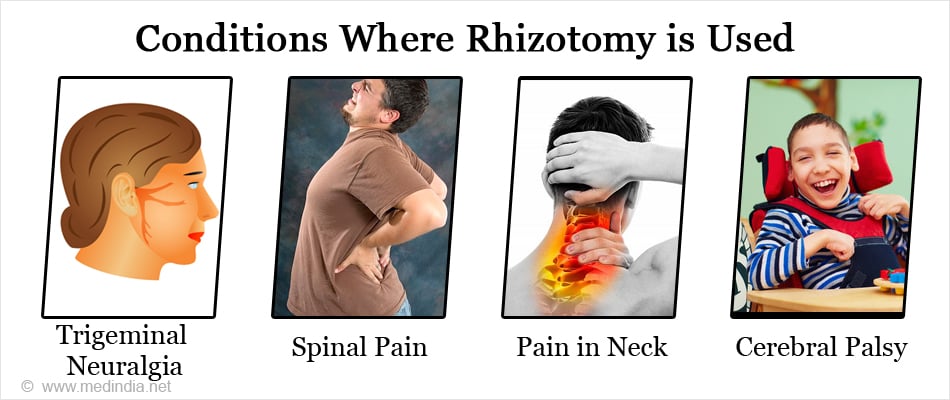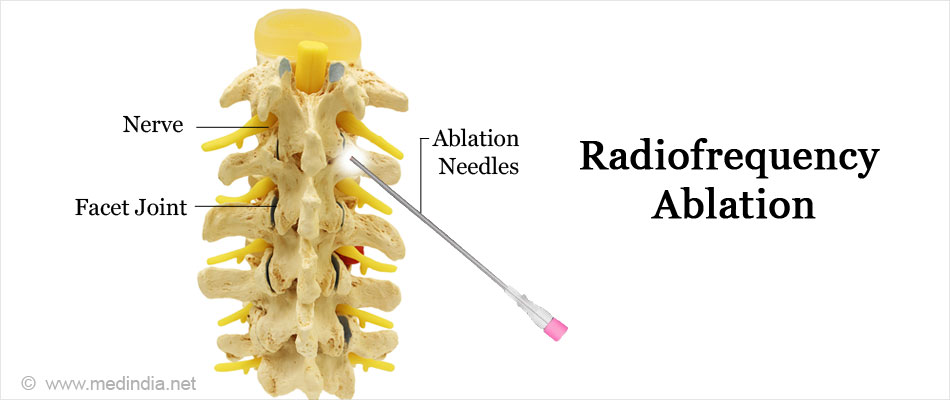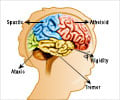What is Rhizotomy?
Rhizotomy is a neurosurgical procedure wherein a sensory nerve is cut or ablated close to its entry into the spinal cord. The procedure selectively destroys problematic nerve roots in the spinal cord and is done to relieve symptoms associated with neuromuscular conditions like spastic cerebral palsy.
Sensory nerves responsible for sensations of touch, pressure and vibration carry sensory signals from the various parts of the body to the brain. Unpleasant sensations are also carried to the brain via the sensory nerves, where they are interpreted as pain.
Intentional ablation or damage to these nerves blocks the signals to the brain, thereby resulting in pain relief. The nerves emerge from different levels of the spinal cord as two groups – the dorsal group which contains sensory nerves, and the ventral group which contains motor nerves. These groups then join together and supply to different parts of the body.
Why is it done?
Rhizotomy is done for the following indications:
- Trigeminal neuralgia: The trigeminal nerve is a nerve that carries pain and other sensations from the face to the brain. Trigeminal neuralgia causes sudden, sharp and shooting pain in the face in the presence of certain stimuli like chewing or exposure to cold. Rhizotomy is done for the neuralgia when medications and other treatments fail to provide relief from the pain. However it can produce numbness on the face.
- Spinal pain: Forms of spinal pain that can be treated with rhizotomy include the following:
- Lumbar facet syndrome: This condition is caused by inflammation and pain of the lumbar facets that are parts of the lower vertebrae that attach to the adjacent vertebrae; they allow movements of the back. The nerves supplying the facets can be damaged using rhizotomy, thereby resulting in pain relief.
- Chronic discoid back pain: The discs are soft cushions between the vertebrae. Worn out discs in the lower spine can result in compression of the nerves emerging from the spinal cord resulting in back pain.
- Pain in the neck: Pain in the neck can result from arthritis, which can be relieved with rhizotomy.
- Spinal pain due to cancers: Cancers of the back may involve nerves resulting in back pain.
However, other less invasive and more effective techniques like improved medications and spinal cord stimulators have resulted in less preference for procedures like rhizotomy as these are more permanent and cannot be reversed.
- Spasticity. Spasticity is a condition where the muscle tone is increased resulting in pain, and difficulty with gait and balance. It is commonly noted in children affected by cerebral palsy. Spasticity in these kids is corrected by a procedure called selective dorsal rhizotomy where the sensory nerves in the dorsal nerve roots are cut or destroyed. Therefore, the unpleasant signals cannot reach the brain resulting in relief of pain. Selective dorsal rhizotomy helps to improve gait and balance, relieve pain and calm down an overactive bladder.

How do you Prepare for Rhizotomy?
Your doctor will ask you to undergo several tests to confirm the underlying diagnosis and make sure that you will benefit from the treatment.
For example, if you suffer from trigeminal neuralgia or spinal pain, you may need to undergo a magnetic resonance imaging or an MRI test. For an MRI, you will be placed inside a narrow tube, which can sometimes make you feel claustrophobic, if you have a fear of enclosed spaces. Few centers do offer more open MRI machines, but the drawback is that the pictures may not be as clear. The MRI machine makes loud clicking noises and it is advisable to ask for earplugs to help block these noises out.
Routine tests:
You will also have to undergo some routine tests before the procedure which include the following:
- Blood tests like hemoglobin levels and blood group
- Urine tests
- ECG to make sure that your heart is functioning properly
- Chest x-ray
In older group of patients, a detailed assessment of the heart maybe required.
What Happens during the Procedure?
Type of Anesthesia – Most rhizotomy procedures are done under general anesthesia. You will be asleep during the procedure and will not be aware of what is going on. If you undergo rhizotomy using chemicals like glycerol injection, you will be sedated with intravenous medications.
Pre-operative Check-up – Routine tests as indicated above are ordered a few days before the surgery. Admission may be required a day before the surgery. You will be advised to stop taking aspirin or blood thinners a few days before the procedure.
Fasting before surgery - Overnight fasting is required and occasionally intravenous fluid maybe required to keep you well hydrated. Sedation is sometimes required for good overnight sleep before the surgery.
Shift from the ward or room to the waiting area in the operating room - An hour or two before the surgery, you will be shifted to the operating room waiting area on a trolley.
Once the surgical room is ready, you will be shifted to the operating room.
Shift to the Operating room - The ambiance in the operating room can be a bit daunting and a small amount of sedation can help you overcome the anxiety. From the trolley, you will be shifted on to the operating table. As you look up, you will see the operating light console and at the head end will be the anesthesia machine. There may also be monitors to check oxygen levels, ECG and other vital parameters. A constant beeping sound may be present from the monitors, which may sometimes be irritating.
Anesthesia before surgery - The anesthetist will inject drugs through an intravenous line and make you inhale some gases through a mask that will put you in deep sleep. Once you are in deep sleep, a tube will be inserted into your mouth and windpipe to administer the anesthesia gases to overcome pain and keep you comfortable.
During the procedure
Most rhizotomy procedures are done under general anesthesia, though procedures like facet rhizotomy can be done under local anesthesia as well. An imaging technique called fluoroscopy or CT fluoroscopy is used to locate the nerves that require to be ablated and to guide the instruments to the correct position.
You will be positioned according to the type of the surgery that you will be undergoing. For example, if you have a problem in your lower back, you will be made to lie on your stomach with paddings for your bony parts. For the procedure using glycerol injection for trigeminal neuralgia, you will be kept in a seated position.
For the treatment of trigeminal neuralgia, the instruments are usually inserted through the cheek and extended to the origin of the trigeminal nerve through the opening at the base of the skull.
1. Surgical sectioning: In this procedure, the sensory nerves responsible for carrying the pain signals are identified and cut close to the spinal cord.
Removal of parts of the vertebrae called laminae, may be necessary when the surgery is done on the lower spine; this part of the procedure is called laminectomy. The laminae are kept attached at the supraspinous ligament. The dura mater, the tough tissue that encloses the brain and spinal cord, is opened and the spinal cord is exposed. The dorsal nerve roots are then identified, confirmed by stimulation, and then cut or ablated. The dura mater is then closed, the laminae are fixed in place and the skin incision is closed.
In selective dorsal rhizotomy, the neurosurgeon makes about a one-inch long cut (incision) in the middle of the child's lower back through which he makes a small window (laminectomy) in the spine to expose the nerve fibers. The nerves that control motion (motor nerves) are identified and separated from the nerves that control feeling (sensory nerves). The motor nerves are moved away to ensure they are not cut by mistake.
The sensory nerves are separated into smaller bundles. Each sensory root is divided into several rootlets. Electrical stimulations are used to test which sensory nerve rootlet responds abnormally. This is called neurostimulation monitoring. These rootlets are cut in order to reduce the spasticity after the operation.
The percentage of abnormal nerves cut is generally about 60% of the sensory nerve fibers and depends on the assessment before the operation and the results from the neurostimulation monitoring.
2. Radiofrequency ablation or radiofrequency thermal lesioning: During this procedure, a hollow needle is inserted close to the nerve that requires to be destroyed when you are sedated. You are then woken up to confirm the correct positioning of the needle by passing a small electric current through an electrode. You will feel a tingling in the area of distribution of the nerve. You will be asked to indicate the location of the tingling sensation. This spot indicates the part of the nerve that is involved in the pain. A local anesthetic is injected and the nerve fiber is then injured by applying heat. The needle and electrode are then removed.

3. In balloon rhizotomy, a cannula or a needle is first inserted to lie close to the nerve that needs to be damaged. A catheter with a balloon is then passed through the cannula, and the balloon is inflated so that it compresses the nerve against tough tissue like the dura mater, thereby damaging it. Once the procedure is done, the balloon is deflated and the catheter and the cannula are removed.
4. Injection of chemicals: Damage to the nerve root can also be brought about using an injection of glycerol or alcohol in the area surrounding the nerve root. A small amount of sterile glycerol is injected, which damages the nerve and blocks pain signals.
What Happens after the Procedure?
Waking up from anesthesia – Once the surgery is over, if you have received general anesthesia, you will wake up and the tube down the windpipe will be removed. You will be asked to open your eyes before the tube is removed. You will be sedated and the voice of the anesthetist may be faint. Once the tube is out, you may have cough and sometimes nausea.
There may be a tube going into the stomach called a nasogastric or Ryle’s tube to keep it empty. There will also be an intravenous line. You will remain on oxygen. Once fully awake, you will be shifted on the trolley and taken to the recovery room.
Recovery after Rhizotomy
Recovery room – In the recovery room, a nurse will monitor your vitals and observe you for an hour or two before shifting you to the room or a ward.
You may experience some temporary numbness in the region supplied by the damaged nerves. You may be discharged on the same day or the next. You will have to visit the hospital for follow-ups as recommended by your doctor.
What are the Risks & Complications of Rhizotomy?
Complications following rhizotomy may include the following:
- Loss of sensations and numbness in the area of distribution of the nerve. Anesthesia dolorosa may occur following damage to the trigeminal nerve, where you may experience numbness in the face, along with pain in the numb area
- Difficulty in chewing if the procedure is done for trigeminal neuralgia
- Spinal deformities like excessive forward or sideward bending of the spine may occur in procedures where laminectomies are done in children with cerebral palsy. Therefore, it is important for the doctor to check the spine alignment on a regular basis until the child reaches skeletal maturity
- Meningitis: The meninges are protective coverings of the brain and spinal cord. Meningitis refers to infection or inflammation of these membranes









